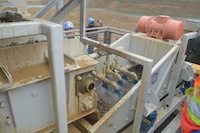
Features
Aggregates
Demonstrating water conservation
April 24, 2015 By Andrew Snook
 Haver & Boecker demonstrated the Tyler Hydro-Clean mobile washing plant at aquarry near Slippery Rock, Pa.
Haver & Boecker demonstrated the Tyler Hydro-Clean mobile washing plant at aquarry near Slippery Rock, Pa. April 24, 2015 – A well-known water conservation technology has found its way into washing equipment for the sand and gravel industry, and the natural stone and recycling industries in North America, courtesy of Haver & Boecker Canada’s Hydro-Clean mobile washing systems.
The Hydro-Clean’s design features angled nozzles using high-pressure water to clean contaminated waste materials, converting it into sellable product, while reducing water consumption by up to 75 per cent, when compared to traditional washing technologies. It is designed to recycle up to 90 per cent of the water it uses each cycle.
After dirty material is fed into the hopper, the material moves from the hopper into the washing drum.
“There’s an opening between the hopper and the washing drum, where material passes through the opening and builds up on a discharge belt, which is powered by a VFD, and it builds up to an area just under a washing head that rotates,” explained Haver & Boecker process engineer Michael Honea, during his company’s Hydro-Clean Demo Day, held on April 23 at Glacial Sand & Gravel in Slippery Rock, Penn.
The washing head rotates the material at 90 rpm, spraying water on it at high pressures. The angled spray nozzles create a shoveling effect to turn the material, washing it from all sides. The material is then fed via conveyor to a vibrating screen where the final rinse process takes place.
The Hydro-Clean is designed to clean raw material mixtures with particle sizes of 0 to 80 mm, and offers capacities up to 360 TPH. The material throughput rates are adjustable according to the level of contamination.
It can be used as a single solution or be added to an existing process, or alternatively, be used as a complete solution that includes downstream screening machines, dewatering screens and water circulation.
The lower water consumption allows the Hydro-Clean to be built more compact than traditional washing technologies, and weighs up to 60 per cent less than log washers or scrubbers, while its modular design and small footprint are designed to reduce electricity consumption.
The system is offered in three sizes:
HCS350
Maximum feed size: 2.5”
Capacity: Up to 18 (M) TPH
System power requirements: 54 HP
HC water consumption: 26 to 30 GPM
Rinse screen: 2’ x 4’
Decks: 1
Screen action: Linear
Rinse screen water consumption: 36 GPM
Total water consumption: 52 to 66 GPM
HCS1000
Maximum feed size: 6”
Capacity: Up to 180 (M) TPH
System power requirements: 199 HP
HC water consumption: 70 to 125 GPM
Rinse screen: 6’ x 16’
Decks: 2 to 3
Screen action: Linear
Rinse screen water consumption: 300 to 600 GPM
Total water consumption: 370 to 725 GPM
HCS2000
Maximum feed size: 6”
Capacity: Up to 360 (M) TPH
System power requirements: 349 HP
HC water consumption: 140 to 211 GPM
Rinse screen: 6’ x 20’
Decks: 2 to 3
Screen action: Linear
Rinse screen water consumption: 300 to 600 GPM
Total water consumption: 440 to 811 GPM
For more information, visit http://www.havercanada.com.
Print this page